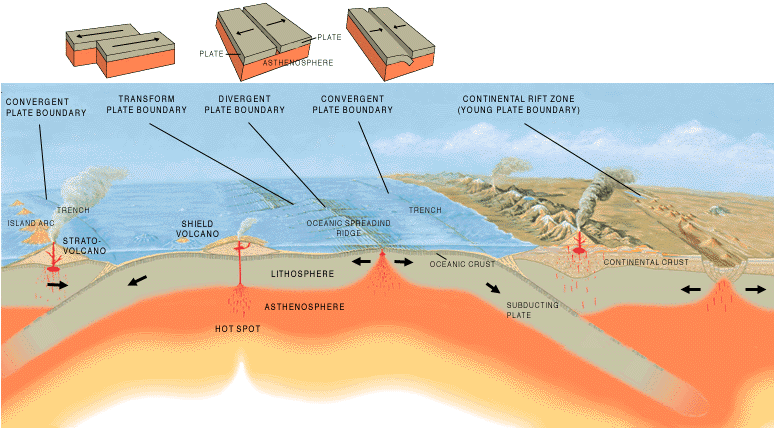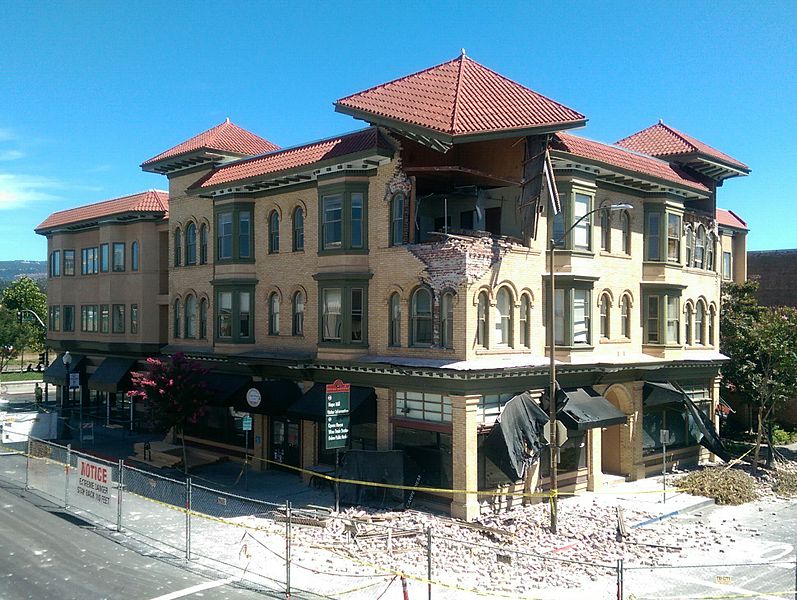We continue exploring the biggest conundrums in Earth sciences in this third post of the known unknowns. In the two previous instalments of the series we’ve discovered what the major questions still to be answered about the early days of planet Earth and its inner workings are. We now move onto the planet’s surface. The advent of plate tectonic theory, arguably one of the biggest advancements in the geosciences of the past century, has allowed us to far better understand how continents are built and the hazards associated with moving plates. Nevertheless, there is still much we do not comprehend, opening the door for hugely exciting and innovative research opportunities.
Tectonic-plate motion and deformation

A cross section illustrating the main types of plate boundaries (Image Source: WikimediaCommons; Author: Jose F. Vigil. USGS, http://pubs.usgs.gov/gip/earthq1/plate.html)
- What is the relative importance of the forces driving plate tectonics: slab pull, slab suction, mantle drag, and ridge push? (e.g., Conrad & Lithgow-Bertelloni,JGR, 2004; Negredo et al., GRL, 2004, vs. van Benthem & Govers, JGR, 2010). What is the force balance and the geochemical cycle in subduction zones? (Emry et al., JGR, 2014) How much water (and how deep) penetrates into the mantle? (Ranero et al., Nature 2003) How much subcontinental erosion takes place under subduction areas? (Ranero et al.,Nature, 2000)
- What happens after the collision of two continents? Does continental collision diminish the rate of plate subduction, as suggested by the slab-pull paradigm? (Alvarez, EPSL, 2010) How frequent are the processes of mantle delamination and slab break-off? What determines their occurrence? (Magni et al., GRL, 2013; Durezt & Gerya, Tectonoph., 2013)
- Why are orogens curved when seen from space? (Weil & Sussman, 2004, GSASP 383)
- How well do different approaches to establish plate motion compare? How does the long-term deformation derived from paleomagnetism and structural geology link quantitatively to the present-day motions derived from GPS and from neotectonic patterns of crustal deformation? (Calais et al., EPSL, 2003) How do these last two relate to each other? (Wang et al., Nature, 2012) Can we learn from regional structure of the crust/lithosphere from that link (or viceversa)?
- Are plate interiors moving in steady-state linear motion? How rigid are these and why/when did they deform? (Davis et al., Nature, 2005, and Wernicke & Davis, Seismological Research Letters, 2010).
- How is relative motion between continents accommodated in diffuse plate boundaries? (eg., the Iberian/African plate boundary). What determines the (a)seismicity of a plate contact?
- How/when does deformation propagate from the plate boundaries into plate interiors? (e.g., Cloetingh et al.,QSR, 2005)
- What is the rheological stratification of the lithosphere: like a jelly sandwich? Or rather like a creme brulée? (Burov & Watts, GSA Today, 2006). Is the lower crust ductile? Is strength concentrated at the uppermost mantle? Or just the other way around? (e.g., McKenzie et al., 2000, JGR; Jackson, GSA Today, ; Handy & Brun, EPSL, 2004; and a nice blog post).
- Does the climate-controlled erosion and surface transport of sediment modify the patterns of tectonic deformation? Does vigorous erosion cause localized deformation in the core of mountain belts and prevent the propagation of tectonic shortening into the undeformed forelands? Does the deposition of sediment on the flank of mountains stop the frontal advance of the orogen? Is there field evidence for these effects predicted from computer models? (Philip Allen’s blog) (Willett, JGR,1999,; Whipple, Nature, 2009; Garcia-Castellanos, EPSL, 2007)
- Can earthquakes be predicted? (Heki, 2011, GRL; Freed, 2012, Nat.Geosc.). How far away can they be mechanically triggered? (Tibi et al., Nature, 2003). Little is known about how faults form and when do they reactivate, and even worse, there seems to be no clear pathway as to solve this problem in the near future. Unexpected breakthroughs needed.
- How can the prediction of volcanic eruptions be improved? What determines the rates of magma accumulation in the chamber and what mechanisms make magmas eruptible? See for example this article on the Yellowstone Caldera and this paper regarding volcanic uplift.
- How much of the Earth’s surface topography is dynamically sustained by the flow in the mantle? In many regions, the elevation of the continents does not match the predictions from the classical principle of isostasy for the Earth’s outer rigid layer (the lithosphere). This deviation is known as dynamic topography, by opposition to isostatic topography. But what are the mechanisms responsible? Can we learn about the mantle dynamics by estimating dynamic topography? (Braun, Nature Geoscience, 2010). Can the hidden loads needed to explain the accumulation of sediment next to orogens (foreland basins) be linked to these dynamic forces? (Busby & Azor, 2012).
- How do land-forming processes react to climate change at a variety of scales, ranging from the Milankovitch cycles to the late Cenozoic cooling of the Earth? Is there a feedback from erosion into climate at these time scales, through the Carbon cycle and the weathering of silicates, for example? What is the role of the surface uplift and erosion of Tibet on the drawdown of atmospheric CO2 over the Cenozoic? (Garzione, Geology, 2008)
Have you been enjoying the series so far? Let us know what you think in the comments section below, particularly if you think we’ve missed any fundamental questions!
In the second to last post in the series we will outline the top outstanding research questions with regards to the Earth’s surface: Earth’s landscape history and present environment.
By Laura Roberts Artal, EGU Communications Officer, based on the article previously posted on RetosTerricolas by Daniel Garcia-Castellanos, researcher at ICTJA–CSIC, Barcelona


Pingback: ¿Por qué tiembla España? – Otras miradas
Pingback: ¿Por qué tiembla España? « L'esquella de la torratxa
Pingback: The known unknowns – the outstanding 49 questions in Earth Sciences (Part IV) | GeoLog